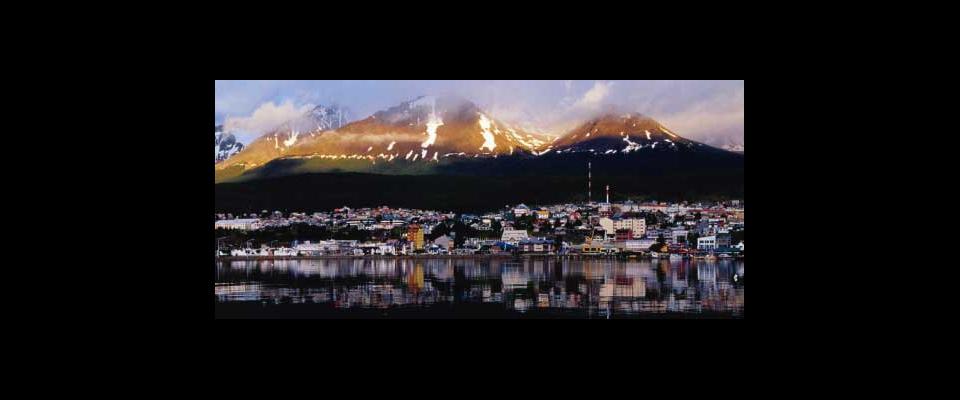Darwin Visited (Near to) Here.
Of all the places I visited, Ushuaia, the biggest city in Tierra del Fuego, most aggressively marketed itself as a Charles Darwin destination. Which is how one explains “The Adventure of the Beagle,” the musical, or as it’s called there, “El espectáculo del fin del mundo,” the “show at the end of the earth,” a production of the tourist-friendly Centro Beagle.
I arrived at the Beagle Center an hour before the show and bought a ticket (labeled “boarding agreement”) from a young man in a sailor hat who waved me into the waiting room.
The lobby was huge and featured wooden tables arranged around the aft end of a scale-model replica of the Beagle. It was empty, so I grabbed a bar stool and waited, as the lobby speakers blasted a looped recording of Handel’s “Coronation Anthem, Zadok the Priest.” Four repeats of the anthem later, I wondered if they would perform the show for a solo, although highly enthusiastic, spectator. But ten minutes before show time, a group of twenty or thirty cruise ship passengers arrived, with a tour director in tow. They seated themselves at a long table and ordered pre-performance Argentine wines. A few actors in wide-brimmed floppy hats and silver-blue neckties that made them look more like Parisian pastry chefs than 19th-century sailors emerged and pretended to swab the decks.
Before the violins could strike up a seventh chorus of the “Coronation Anthem,” the cruise ship passengers rose in unison at a signal from their tour director and shuffled through a curtain in the back of the Beagle replica. I followed them onto the ship and climbed into a seat near the top of the converted cabin, looking down at the deck planks and the sail-less main mast. My view also encompassed Tierra del Fuegian glaciers made of crinkly white fabric draped over a metal framework. The ship sat in the middle of a big-top-style tent, and the black walls, with inset starry lights, rose high overhead.
Then everything went dark. The audience went quiet.
The production began with a small video screen showing—what else?—Darwin as an old man in his study, recounting the origins of the voyage in a frail, Argentine-accented voice. Suddenly, our hero appeared in the flesh, emerging from a door in the Beagle’s fore cabin dressed in a long corduroy jacket, long red pants, and a pink shirt, and carrying what looked to be a rusty red suitcase emblazoned with flowers. The actor’s long, straight hair was dyed blond with visible dark roots, and worn in an unruly mop. Synthetic muttonchops were glued to his cheeks.
Soon, the sailors that had earlier been pretend-swabbing the deck appeared, and then an appropriately costumed Robert FitzRoy and another officer, and then, as Monty Python might say, things got silly. They broke out in song, in English. The lyrics, transcribed on the “boarding agreement,” read:
We’ll fight the roaring seas
We shall face no defeat
All across the Seven Seas
The Beagle will succeed.
When the sailors finished singing and stomped off, Darwin and FitzRoy took center stage for a duet about searching for truth (in Darwin’s case) and the work of the Lord (in FitzRoy’s case). The lyrics—Darwin: “I’ll listen to the calling of the Earth,” FitzRoy: “uncover all of nature’s divine perfection and more”—played on two falsehoods, the first being that Darwin had any notion of evolution by natural selection before, or even really during, the Beagle’s voyage. (Mostly, he had inklings that all species were not created exactly as they were and unchanged over time.) The second untruth was that FitzRoy wanted Darwin along to prove the literal truth of the Bible.
The musical continued to hammer that point, portraying FitzRoy as a fundamentalist blowhard, unwilling to tolerate dissent on religious matters. It staged Darwin as a tormented evolutionist, torn between his friendship with the captain and the new scientific truths he was discovering.
I wasn’t surprised, since these are fairly easy assumptions about Darwin and the Beagle voyage. In fact, it’s probably easier to present this material than to risk audience cognitive dissonance by trying to tell what actually happened. Probably more exciting, too. Because the real drama-worthy conflict on the Beagle was man vs. the elements, which is hard to render in musical format.
Far from being a biblical literalist, the real FitzRoy wanted Darwin to study science. “Anxious that no opportunity of collecting useful information, during the voyage, should be lost; I proposed to the hydrographer that some well-educated and scientific person should be sought,” FitzRoy wrote in his Narrative. Although FitzRoy later became a staunch critic of The Origin of Species, standing up at one meeting with Bible in hand to say that he “regretted the publication of Mr. Darwin’s book,” there is little evidence to suggest he was particularly religious while on board. FitzRoy might have made the voyage even without the Admiralty’s backing—he was ready to do so when they stepped in —because he had another important task: To return three captured indigenous people to Tierra del Fuego.
Darwin’s was the second voyage of the Beagle to South America. The first departed England in 1825 under the command of Captain Pringle Stokes. Like many travelers, Stokes found Patagonia dreadfully dull. Faced with the idea of more time there, he shot himself. FitzRoy was his flag lieutenant, and he took over and set off to survey Tierra del Fuego. Almost immediately, a group of Fuegians stole one of his whale-boats. FitzRoy gave chase and took hostages, hoping that this would force its return. Much to his surprise, however, the Fuegians appeared satisfied with that bargain. He later traded another family some beads and buttons for a boy, and seized on the idea that he would take them back to London, have them educated, and return them a few years later.
He gave the three men and one woman the names York Minster, Boat Memory, James Button, and Fuegia Basket, and soon they were meeting the queen, ice-skating, and learning to eat with utensils.
Although Boat Memory died of an illness in England in 1830, the others boarded the Beagle with Darwin a year later and set off for South America, along with a missionary, to convert their friends back home. “Jemmy” Button was the “universal favourite,” according to Darwin, and he remembered Jemmy sympathizing with his seasickness. York Minster, the oldest of the group, was mostly quiet and reserved; Darwin described him as “taciturn” but “violently passionate” when excited. Fuegia Basket, the only female, Darwin described as a nice girl and quick learner.
All the Fuegians taken by FitzRoy except York Minster were part of a tribe called the Yamana, semi-nomadic people who lived in small, self-contained family groups, and built small huts near oyster beds and then moved when the oyster supply gave out. They returned to old huts after intervals long enough to allow the oyster stock to replenish. They also clubbed cormorants and seals, fished, and speared the occasional guanaco. They didn’t wear clothing, and smeared themselves with seal grease to stay warm. The Yamana communicated with each other by lighting signal fires along the coast—Magellan saw these in the 1500s and named the place Tierra del Fuego or “Land of Fire” in Spanish. The Fuegians lit a large signal fire when the Beagle arrived this second time. FitzRoy recorded being “astonished at the rapidity with which the Fuegians produce this effect … in their wet climate, where I have been, at times, more than two hours attempting to kindle a fire.” When they landed the next day, it was amongst “savages.”
The musical treated its Fuegians with a similar level of condescension. Jemmy Button’s actor turned him into a happy, effeminate Englishman, wearing gloves and shiny pink clothing and sipping tea with a raised pinky. (Darwin did describe Jemmy as “vain of personal appearance.”) The musical implied a romantic relationship between him and FitzRoy, which could have been Argentine actors subtly expressing their disdain for the English, or could have been over-acting. Or it could have been entirely unintentional. Whichever the case, the show proceeded to the point at which FitzRoy finally arrived back near their home.
On January 18, 1833, FitzRoy anchored at the eastern end of the Beagle Channel and set off with Darwin, a small crew, and the missionary, Richard Mathews, to return the Fuegians to Jemmy Button’s old homeland in Ponsonby Sound, an inlet south of modern Ushuaia. The small sailboat carried all of the items selected by Mathews’s missionary society to help the newly converted turn from savagery to proper Victorians. Darwin noted with disgust that it included wine glasses, tea-trays, fine white linen, and a mahogany dressing case.
After three days of sailing, they found a small cove identified by Jemmy Button as his former home, Wuluaia. They landed and on the next day, Jemmy’s family arrived. (In the musical, the family was represented by dozens of grunting Yamana puppets in canoes.) The Beagle crew optimistically set to work building houses for Mathews and his prospective neighbors, and planting vegetable gardens. On January 28, FitzRoy turned the boats around to take a quick tour of the Beagle Channel.
As they sailed back toward Wuluaia a few days later, FitzRoy noticed a group of Fuegians, whom he didn’t recognize, wearing white linens. Mathews, much to the captain’s relief, came out to greet the ship, looking mostly as they had left him. But he had had almost everything stolen. He had been threatened. His garden had been trampled. “He did not think himself safe among such a set of utter savages,” FitzRoy wrote. FitzRoy packed Mathews back to the Beagle.
At least Jemmy, Fuegia Basket, and York Minster seemed to have reintegrated nicely. The Beagle returned to Wuluaia one year later, in February 1834. They found the wigwams empty and no sign of Jemmy onshore. Soon a canoe appeared flying a flag. “Until she was close alongside,” Darwin wrote, “we could not recognize poor Jemmy.”
“It was quite painful to behold him,” Darwin lamented. “Thin, pale & without a remnant of his clothes, excepting a bit of blanket round his waist…. I never saw so complete and grievous a change.”
FitzRoy rushed Jemmy below and had him clothed in English finery, and they proceeded to take tea together. Jemmy still remembered English, and had taught his family and his new wife. The next morning, Jemmy told FitzRoy that York Minster and Fuegia Basket had stolen all his clothes and left in the middle of the night to return to York’s homeland. And a warring tribe from the northeast, called “Ohens” by Jemmy—now called the Onas—had raided the settlement, forcing Jemmy to flee to his own island.
Still, Jemmy did not wish to return to England. He distributed some gifts, including a few spearheads for Darwin and a bow and arrows for his schoolmaster in England. The gifts were as comically inappropriate as the tea trays sent the other direction.
Perhaps the musical had absorbed a bit of Darwin’s grief. When Jemmy reappeared near the end, he had lost the tight breeches and teacup and had acquired a club and a loincloth. His hair was longer and stringier. He presented FitzRoy with an animal skin and intimated via grunts that he didn’t want to go back to England, because he was happy being a savage. Jemmy and co. (still played by puppets) then grunted their way off-stage while a deeply chastened FitzRoy took the spotlight for his final solo, lamenting his pride and selfishness. “I played with this boy’s soul,” he crooned. “I took a life and treated it as if it was mine, my own to guide, to take to a better world.” The real FitzRoy, not quite so tormented, reluctantly sailed out of Ponsonby Sound after two days.
After the singing FitzRoy had belted out his musical lesson, the show reached its conclusion. The video screen came down again, with the old Darwin saying it was too bad he and FitzRoy didn’t see eye-to-eye on the whole evolution thing, but that the Beagle trip had been a good time all around. Then the sailors came back for one more rousing chorus of “Our spirits will never die / The Beagle is flying high,” and the stage went dark.
I tracked down Marcos Gomez, the blue-eyed actor who had played Darwin, in the Beagle Center lobby, watching the cruise ship passengers enjoy a nice local seafood dinner under a poster of naked Fuegians. Gomez was 25, with blond hair still damp from the performance, and as he peeled back his rubber sideburns to reveal a hidden microphone, he told me he had studied acting in Buenos Aires.
“Darwin is a fun character to play. But I would like to be the captain. He has a stronger role.” He pantomimed singing and then shrugged. “You know. But last year, I was a sailor.” He found his picture in the program and pointed it out.
I asked what he thought of the Yamana, and he became much more animated. “They’re considered the most primitive of the tribes,” he said. “But really, they were very smart. They had lots of means of obtaining food. They lived in complete harmony with the land. If a whale washed up, they’d eat that. They covered themselves in grease for the cold.”
The next morning, looking for an academic of sorts to explain a bit more about current perceptions of Fuegians, I made my way through swirling mist to the local history museum. It called itself the “end of the world” museum, a tribute to Ushuaia’s self-declared status as the southernmost city in the world. (This is disputed by Chile, which says that its own naval settlement, Port Williams, is farther south.)
The Yamana merited only a brief mention alongside the names and dates of famous European explorers who had visited the area. “They had a number of beliefs commonly found in other primitive peoples,” one plaque read (in English). “Yamana stories are known to be simple, with little humor or keenness.” I went to the front desk and asked if I could speak to the director, and soon found myself in the office of a very professorial-looking Argentine. He lit a cigarette and introduced himself as Santiago Reyes. We chatted briefly about Darwin’s visit. I asked what people in Tierra del Fuego, other than people who worked in tourism, thought of Darwin. “They don’t,” he answered quickly.
Reyes burned through three cigarettes, and then switched to drinking maté.
“Darwin criticized slavery,” I said. “He defended the Indians of Patagonia. Then he arrived in Tierra del Fuego and was very critical of the indigenous people. He called them savages. Why do you think that was?”
Reyes took a sip from the maté gourd and reached back into his desk to pull out a postcard that he then slapped on the desk in front of me. It was a black-and-white picture of a Yamana family squatting in front of some trees, naked except for loincloths.
He pulled out another postcard, of another group of Indians from the northern part of the island. The people wore coats made from guanaco furs and stood upright with good posture. “To a European, these Indians look better,” he said, referring to the northern Indians. “Darwin was very young. With very little experience. The Indians of the north were more normal for him.”
Reyes didn’t excuse Darwin’s naiveté, but his side-by-side comparison provided an explanation. For a 23-year-old from a land where everyone wore wool and lived in brick houses and drove horse-drawn carriages, people sleeping naked in the rain must have seemed a breathtaking contrast. This wasn’t just the most curious and interesting spectacle he ever beheld, it was something he repeatedly referenced later, even in his scientific work. The Descent of Man, published in 1871, isn’t just Darwin grappling with a lifetime of abolitionism. It’s his attempt to finally answer a question that had leaped out at him nearly four decades earlier in the savage conditions of Tierra del Fuego.
That night in the hostel kitchen I cooked an Argentine steak, sat down to eat, and found myself opposite a young traveler. He slouched in his chair, pushed his noodle dinner around with his fork, and looked out the window at the overcast night sky. We exchanged the standard introductory formalities, and after learning he was 19, from Canada, and named Thomas, I asked how long he had been in Ushuaia.
“Too long, really,” he said. “This town just doesn’t do it for me. It’s too much like Canada. I can get rain and snow at home. They’ve got the same scenery. Same forests. They even took our beavers.”
(Beavers have become the brown scourge of Tierra del Fuego. Someone had the idea of introducing them in the early 1900s, to be hunted for their pelts. The pelt market collapsed almost immediately, but the beavers liked the scenery and stayed on to eat the island alive.)
“At least,” I countered, “your beavers have left a trail of destruction and carnage.”
“That’s true,” Thomas nodded. “No natural predators. Reproducing like crazy. I saw all the dead trees in the park today.”
He looked over at the book I was reading.
“Charles Darwin,” he said. “Why have I heard that name before?”



















